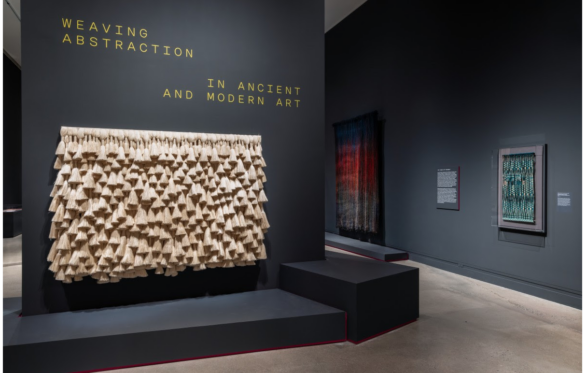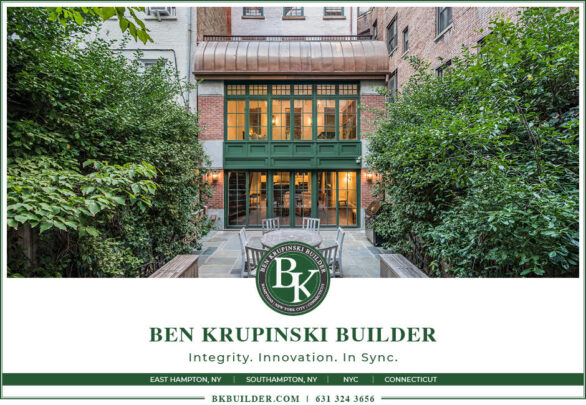
| Weaving Abstraction in Ancient and Modern Art installation view. Image: © The Metropolitan Museum of Art, photo by Hyla Skopitz. |
| ————————————— |

Central coast artist Tunic. 1000-1476 CE. Peru. Camelid and cotton fibers. 33 × 36 in. (83.8 × 91.4 cm)
The Metropolitan Museum of Art, Purchase, Anonymous Gifts, 2015, (2015.291). Image: © The Metropolitan Museum of Art.
~~~~~~~~~~~~~~~~~~~~~~~~~~~~~

Exhibition Dates: March 5–June 16, 2024
Exhibition Location:
The Met Fifth Avenue, Gallery 913
Weaving Abstraction
in Ancient and Modern Art
~~~~~~~~~~~~~~~~~~~~~~~~~~~~~~
The process of creating textiles has long been a springboard for artistic invention. In Weaving Abstraction in Ancient and Modern Art, two extraordinary bodies of work separated by at least 500 years are brought together to explore the striking connections between artists of the ancient Andes and those of the 20th century. The exhibition features textiles by four distinguished modern practitioners—Anni Albers, Sheila Hicks, Lenore Tawney, and Olga de Amaral—alongside pieces by Andean artists from the first millennium BCE to the 16th century, who, though their names are largely unknown to us, created works of exceptional technical and formal refinement.
The exhibition is made possible by The Modern Circle.
This cross-historical exhibition offers new insights into the emergence of abstract imagery. The constructive nature of weavings, arising from the grid formed by crossing the warp and the weft (the vertical and horizontal elements of the loom), prompted the formal investigation of a geometric iconography that emphasizes the integral relationship between structure and design in textiles, forging distinctive paths to abstraction in both historical periods.
Weaving is one of the oldest and most complex art forms in the Americas, with a rich history beginning 10,000 years ago. Textiles in the ancient Andes—while bold and exceptional in design—were also fundamental to the exchange of information in the pre-Hispanic period, used to swiftly transmit social and political messages in a manner that overcame linguistic and geographic barriers.
—————–

Olga de Amaral, Colombian, born Bogotá, 1932. Alquimia 13
1984. Linen, rice paper, gesso, indigo red and gold leaf. 72 × 62 in. (182.9 × 157.5 cm). Gift of Olga and Jim de Amaral, 1987. The Metropolitan Museum of Art (1987.387) Image: © Courtesy Olga de Amaral. Image © The Metropolitan Museum of Art, photo by Peter Zeray
—————–
Artists of early European modernism and the American fiber arts movement sought to uplift and recenter the medium—commonly relegated to the realm of “women’s work.” Each of the four modern artists featured in the exhibition developed innovative approaches to an ancient medium through deep study of Andean techniques. Within this legacy, they responded to the demands and challenges of the modern industrial society while maintaining a firm commitment to abstraction as the language of modernity. Shown together in this exhibition, these ancient and modern weavings reposition the place of textiles in global art history.
Weaving Abstraction in Ancient and Modern Art will feature more than 50 works, including new acquisitions. The exhibition will also include loans from Buffalo Museum of Science; The Museum of Modern Art; Cooper Hewitt, Smithsonian Design Museum; Museum of Arts and Design, New York; The Josef and Anni Albers Foundation; Lenore G. Tawney Foundation; and private collectors.
—————–

Central coast artist Shirt. 1460-1540. Peru. Camelid hair, cotton. 19 x 47 in. (48.3 x 119.4 cm). The Metropolitan Museum of Art, Gift of Arthur M. Bullowa, 1983, (1983.497.1). Image: © The Metropolitan Museum of Art.
——————–
The exhibition is curated by Iria Candela, Estrellita B. Brodsky Curator of Latin American Art in the Department of Modern and Contemporary Art, and Joanne Pillsbury, Andrall E. Pearson Curator of the Arts of the Ancient Americas in The Michael C. Rockefeller Wing.
Weaving Abstraction in Ancient and Modern Art will be accompanied by an issue of The Metropolitan Museum of Art Bulletin.
The Met’s quarterly Bulletin program is made possible in part by the Lila Acheson Wallace Fund for The Metropolitan Museum of Art, established by the cofounder of Reader’s Digest.
The exhibition is featured on The Met’s website as well as on social media.
—————————
|
|
—————————
===========================================================

AAQ / Resource: Ben Krupinski Builder
_________________________________________________
